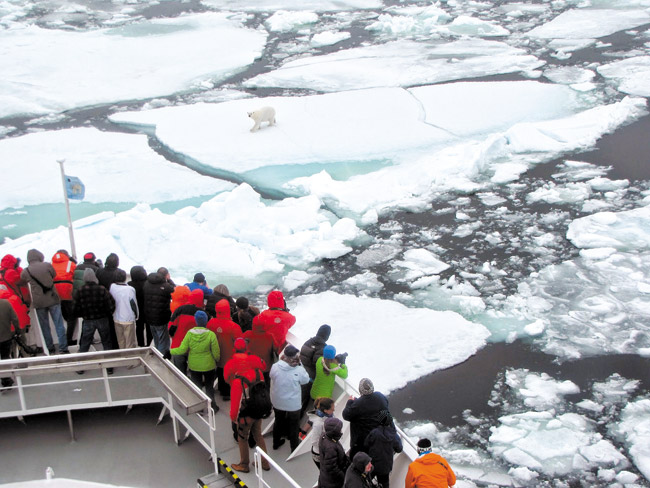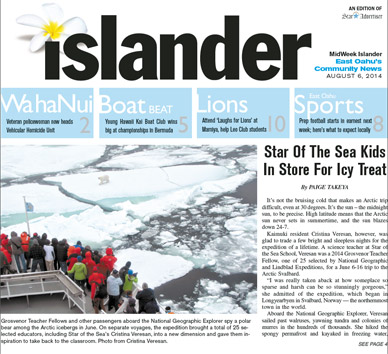Star Of The Sea Kids In Store For Icy Treat

Grosvenor Teacher Fellows and other passengers aboard the National Geographic Explorer spy a polar bear among the Arctic icebergs in June. On separate voyages, the expedition brought a total of 25 selected educators, including Star of the Sea’s Cristina Veresan, into a new dimension and gave them inspiration to take back to the classroom. Photo from Cristina Veresan.
It’s not the bruising cold that makes an Arctic trip difficult, even at 30 degrees. It’s the sun the midnight sun, to be precise. High latitude means that the Arctic sun never sets in summertime, and the sun blazes down 24-7.
Kaimuki resident Cristina Veresan, however, was glad to trade a few bright and sleepless nights for the expedition of a lifetime. A science teacher at Star of the Sea School, Veresan was a 2014 Grosvenor Teacher Fellow, one of 25 selected by National Geographic and Lindblad Expeditions, for a June 6-16 trip to the Arctic Svalbard.
“I was really taken aback at how someplace so sparse and harsh can be so stunningly gorgeous,” she admitted of the expedition, which began in Longyearbyen in Svalbard, Norway — the northernmost town in the world.
Aboard the National Geographic Explorer, Veresan sailed past walruses, yawning tundra and colonies of murres in the hundreds of thousands. She hiked the spongy permafrost and kayaked in freezing water, seeing Arctic foxes, bearded seals and more along the way.
Out of all those wonders, the polar bears stick out. She recalled one female that playfully trailed the ship, jumping from ice floe to ice floe to peer at the people on board. “The naturalist inferred that she had not seen a boat before because of how curious she was,” Veresan said.
But it was another bear that gave her pause. “In southern Svalbard, we actually saw a pretty old but very underweight male bear,” she said. “At one point, we actually saw it foraging on the ground and eating some seaweed, which obviously for a top predator — a huge carnivorous bear — was really kind of a sad moment.
“It just got me thinking about climate change, the ice melting earlier in the summer and freezing later in the winter, and the impacts of the disappearing ice on the bears.” Even as she sailed past the massive Austfonna ice cap — one of the largest glaciers in the world — she observed that it too is affected by climate change.
When school starts, she will take her experiences into the classroom, giving her students the science to empower them with tools to combat climate change and recognize how their choices can have a positive impact.
“Now that I’ve seen the Arctic, it’s of even greater significance. I feel like I have to bring back this story, and part of it has to be climate change — the conservation of the polar region now has a real first-hand significance to me.”
Veresan also has a blog and photos about her adventure at veresan.com/blog.






